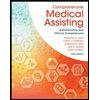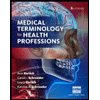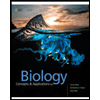
HUMN ANAT&PHYS ALC&MOD MA&P/ET&ACTV LRNG
2nd Edition
ISBN: 9780137374625
Author: AMERMAN
Publisher: PEARSON
expand_more
expand_more
format_list_bulleted
Concept explainers
Question
Chapter 19, Problem 19CYR
Summary Introduction
Introduction:
Antibodies are produced by activated B lymphocytes and they bind to the foreign antigens. Each antibody binds to a unique antigen. The four blood groups—A, B, AB, and O—are based on the presence or absence of A and B antigens. On the other hand, Rh blood grouping is based on the presence or absence of Rh antigen.
Expert Solution & Answer
Want to see the full answer?
Check out a sample textbook solution
Students have asked these similar questions
"Which of the following about transposable elements (TEs) is false?"
RNA transposons move using an RNA intermediate.
DNA transposons make up 3% of the human genome but are disruptive.
Genes can move within the same chromosome via TEs.
The Drosophila P element can only move in germline cells.
Can you explain each answer choices pleae?
What will control the rate of bioremediation of petroleum? (Choose all correct answers)
The availability of the petroleum
The temperature of the water
The availability of oxygen
The percent of the population that has degraded petroleum in the past
Which of the following would lead to a false negative result in a sandwich ELISA (the lab manual refers to this as a direct ELISA- also known as search for antigen)? Mark all correct answers.
antibody was non-specific and bound to something other than the antigen of interest.
too short of a duration when incubating the reagents in the plate.
If there are multiple strains of the pathogen of interest and the antibody does not recognize one of the strains.
Did not sample the correct bodily fluid/area to detect the antigen
concentration of antigen was too low to detect in the patient sample.
inadequate washing was performed after the enzyme linked antibody was allowed to bind.
substrate was exposed to too much light
reusing a pipette that was used to pipette a positive sample.
Chapter 19 Solutions
HUMN ANAT&PHYS ALC&MOD MA&P/ET&ACTV LRNG
Ch. 19.1 - Prob. 1QCCh. 19.1 - Prob. 2QCCh. 19.1 - 3. How does blood regulate temperature and...Ch. 19.1 - 4. What are the four main categories of plasma...Ch. 19.1 - Prob. 5QCCh. 19.2 - Describe the structure of a typical erythrocyte.Ch. 19.2 - Prob. 2QCCh. 19.2 - 3. Walk through the basic steps of...Ch. 19.2 - 4. What is the lifespan of an erythrocyte?
Ch. 19.2 - Prob. 5QC
Ch. 19.2 - Prob. 6QCCh. 19.2 - Prob. 7QCCh. 19.3 - How do granulocytes and agranulocytes differ?Ch. 19.3 - Prob. 2QCCh. 19.3 - Compare the two types of agranulocytes.Ch. 19.3 - 4. How do B and T lymphocytes differ?
Ch. 19.3 - 5. What does a monocyte become in the tissues?...Ch. 19.3 - Prob. 6QCCh. 19.3 - 7. How do the lymphoid and myeloid cell lines...Ch. 19.3 - 8. Where do T and B lymphocytes mature?
Ch. 19.4 - Prob. 1QCCh. 19.4 - Prob. 2QCCh. 19.5 - Prob. 1QCCh. 19.5 - Prob. 2QCCh. 19.5 - 3. How are platelets triggered to aggregate?
Ch. 19.5 - Prob. 4QCCh. 19.5 - How do the intrinsic/contact activation and...Ch. 19.5 - Prob. 6QCCh. 19.5 - Prob. 7QCCh. 19.5 - What is thrombolysis?Ch. 19.5 - Prob. 9QCCh. 19.5 - Prob. 10QCCh. 19.5 - Prob. 11QCCh. 19.5 - Prob. 12QCCh. 19.5 - Prob. 13QCCh. 19.5 - Prob. 14QCCh. 19.6 - Prob. 1QCCh. 19.6 - Prob. 2QCCh. 19.6 - Prob. 3QCCh. 19.6 - Prob. 4QCCh. 19.6 - Prob. 5QCCh. 19 - Prob. 1CYRCh. 19 - Prob. 2CYRCh. 19 - List the seven major functions of blood.Ch. 19 - Prob. 4CYRCh. 19 - Prob. 5CYRCh. 19 - Prob. 6CYRCh. 19 - Prob. 7CYRCh. 19 - Leukocytes are: a. nucleated cells that function...Ch. 19 - Prob. 9CYRCh. 19 - Fill in the blanks: Lymphocytes are derived from...Ch. 19 - Prob. 11CYRCh. 19 - Number the steps of hemostasis in order, putting 1...Ch. 19 - Prob. 13CYRCh. 19 - Prob. 14CYRCh. 19 - Prob. 15CYRCh. 19 - Prob. 16CYRCh. 19 - Prob. 17CYRCh. 19 - 18. Which antigens does a person with blood type...Ch. 19 - Prob. 19CYRCh. 19 - Prob. 20CYRCh. 19 - 1. Explain how blood, being a liquid, enables all...Ch. 19 - Prob. 2CYUCh. 19 - 3. The anticoagulant drug warfarin primarily...Ch. 19 - 4. Cirrhosis of the liver often reduces production...Ch. 19 - 1. A blood sample from your patient shows that she...Ch. 19 - Prob. 2AYKACh. 19 - Prob. 3AYKACh. 19 - Prob. 4AYKB
Knowledge Booster
Learn more about
Need a deep-dive on the concept behind this application? Look no further. Learn more about this topic, biology and related others by exploring similar questions and additional content below.Similar questions
- S. +1269 pts /1500 © Macmillan Learning 0 Resources Solution Penalized Feedback Try Again Draw the final product with stereochemistry and lone pairs. The leaving group has been pre-drawn for your convenience. +100 +100 : 0: + H,C- :0: : 0 0 : +100 +94 possible ✓ +100 K Attemparrow_forward+1269 pts /1500 © Macmillan Learning t/1188d950-dd73-11e0-9572-0800200c9a66/3045511b-267e-4a00-86ca-85dbc62ecb4e/6ac3a0c9-... a □ 出 All Bookmarks Due: Mon, May 26 Resources Solution Penalized Feedback Try Again KX Attempt 3 Draw the final product with stereochemistry and lone pairs. The leaving group has been pre-drawn for your convenience. :0: + нс H,C- :0: : 0:arrow_forwards. +1169 pts /1500 © Macmillan Learning 0 Resources Hint Submit Answer Step 3: This tertiary carbocation intermediate readily undergoes elimination with any weak base to form two possible products. + + H :0: H +94 possible 3a) Draw the minor organic product of elimination. Select Draw Templates More +100 +95 possible # C Major product + Minor product 3b) Draw the major organic product of elimination. Erase Select Draw Templates More C Erasearrow_forward
- Explain the Science & Society on (with links and pictures): ---- Question down below Discuss the ethical, medical, and societal implications of using advanced genetic techniques?arrow_forwardExplain the Disease Mechanism & Impact on (with links and pictures): What causes Leigh Syndrome and why it's so deadly. Which cellular functions, organelles (especially mitochondria), and macromolecules are involved.arrow_forwardExplain the Disease Mechanism & Impact on (with links and pictures): What's going wrong inside the cell and the effects on the human body. Describe metabolism with an emphasis on cellular respiration.arrow_forward
- Explain the Disease Mechanism & Impact on (with links and pictures):arrow_forwardExplain the Science & Society on (with links and pictures): Discuss the ethical, medical, and societal implications of using advanced genetic techniques.arrow_forward↑ LED Tt O Tt e 0 ✓ B > FLORES DIology Second Semester Review 7. Chi Square Analysis: wild dumpy male x ebony wild female F1: All wild wild F2: 142 wild wild males 52 wild ebony males 46 dumpy wild males 17 dumpy ebony males 151 wild wild females 47 wild ebony females 51 dumpy wild females 8 dumpy ebony females What pattern of inheritance is observed for body color? Autosomal recessive Autosomal dominant Sex-linked recessive Sex-linked dominant What are the genotypes of the parents in the P generation? a. XBYdd x XbXbDD b. Bbdd x bbDd c. BBdd x bbDD d. BBX Y x bbXDY How many flies in the F2 generation would you expect to express the dumpy wild phenotype? a. 289.125 b. 97 c. 96.375 d. 293arrow_forward
- 4. This question focuses on entrainment. a. What is entrainment? b. What environmental cues are involved in entrainment, and which one is most influential? c. Why is entrainment necessary? d. Assuming that a flash of darkness is an effective zeitgeber, what impact on circadian rhythms would you expect to result from an event such as the 2024 solar eclipse (assume it was viewed from Carbondale IL, where totality occurred at about 2 pm)? Explain your reasoning. You may wish to consult this phase response diagram. Phase Shift (Hours) Delay Zone Advance Zone Dawn Mid-day Dusk Night Dawn Time of Light Stimulus e. Finally, give a real-world example of how knowledge of circadian rhythms and entrainment has implications for human health and wellbeing or conservation biology. This example could be from your reading or from things discussed in class.arrow_forwardGenerate one question that requires a Punnet Squre to solve the question. Then show how you calculate the possibilities of genotype and phenotypearrow_forwardBriefly state the physical meaning of the electrocapillary equation (Lippman equation).arrow_forward
arrow_back_ios
SEE MORE QUESTIONS
arrow_forward_ios
Recommended textbooks for you
 Comprehensive Medical Assisting: Administrative a...NursingISBN:9781305964792Author:Wilburta Q. Lindh, Carol D. Tamparo, Barbara M. Dahl, Julie Morris, Cindy CorreaPublisher:Cengage Learning
Comprehensive Medical Assisting: Administrative a...NursingISBN:9781305964792Author:Wilburta Q. Lindh, Carol D. Tamparo, Barbara M. Dahl, Julie Morris, Cindy CorreaPublisher:Cengage Learning Human Heredity: Principles and Issues (MindTap Co...BiologyISBN:9781305251052Author:Michael CummingsPublisher:Cengage Learning
Human Heredity: Principles and Issues (MindTap Co...BiologyISBN:9781305251052Author:Michael CummingsPublisher:Cengage Learning Medical Terminology for Health Professions, Spira...Health & NutritionISBN:9781305634350Author:Ann Ehrlich, Carol L. Schroeder, Laura Ehrlich, Katrina A. SchroederPublisher:Cengage Learning
Medical Terminology for Health Professions, Spira...Health & NutritionISBN:9781305634350Author:Ann Ehrlich, Carol L. Schroeder, Laura Ehrlich, Katrina A. SchroederPublisher:Cengage Learning


Comprehensive Medical Assisting: Administrative a...
Nursing
ISBN:9781305964792
Author:Wilburta Q. Lindh, Carol D. Tamparo, Barbara M. Dahl, Julie Morris, Cindy Correa
Publisher:Cengage Learning


Human Heredity: Principles and Issues (MindTap Co...
Biology
ISBN:9781305251052
Author:Michael Cummings
Publisher:Cengage Learning

Medical Terminology for Health Professions, Spira...
Health & Nutrition
ISBN:9781305634350
Author:Ann Ehrlich, Carol L. Schroeder, Laura Ehrlich, Katrina A. Schroeder
Publisher:Cengage Learning
